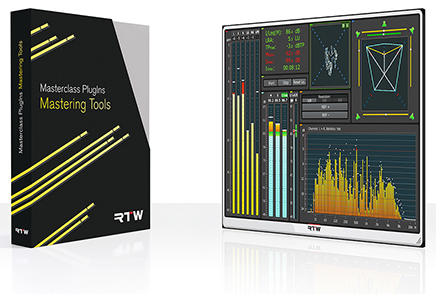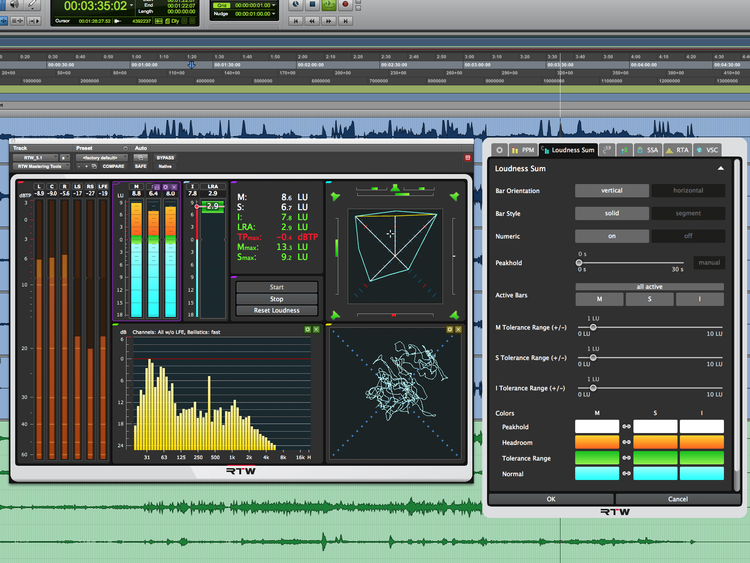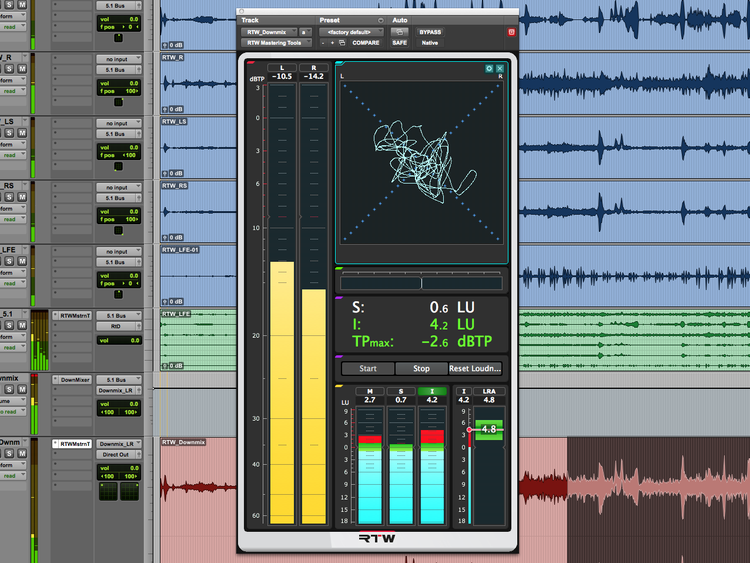New Software Review: Masterclass Mastering & Loudness Tools from RTW

RTW’s “Masterclass Mastering” and “Loudness” tools bring all of the power and flexibility of their acclaimed hardware meters to a cost-effective software package.
RTW, an audio company based in Cologne, Germany, has been designing and manufacturing broadcast-quality metering tools and other devices since 1965.
This year, two new software releases from RTW bring the most essential instruments from their premium series of hardware meters to an new affordable price point with their Masterclass Mastering Tools and Loudness Tools, which operate both as a DAW plugins and in standalone mode.
The Challenge
The state of audio metering has come a long way in the last several years. It’s no longer enough to know just the maximum peak level of a signal—we need meters to hear more like people do, and so the perceived loudness of audio is finally getting the attention it deserves.
The basic human instinct to create the loudest possible mix—driving the Loudness Wars in this generation just as in past past ones—has led to decades worth of complaints from listeners due to squashed and cranked audio in commercials, trailers and songs. And, when that audio hits broadcast output processing, limiting, additional compression and spectral shaping are applied with the goal of a consistent broadcast level, often to the detriment of an original mix.
As audio increasingly moves from traditional broadcast formats to the internet, music services including iTunes, Spotify and even YouTube are now working to improve upon traditional broadcast practices by scanning all audio files and assigning a loudness value to each track to enable playback normalization, which automatically adjusts the overall volume of each file as your playlist lurches into some slamming Ween following a delicate Bach guitar piece.
This makes for a much better listening experience and, because this automatic normalization adjusts the file volume without applying any compression or limiting to the audio, you end up hearing the mix and master as the artist intended, and you no longer have to constantly grab your volume control as your audio stream flows by.
In this context, loudness metering becomes a crucial tool, helping to craft mixes that play well in both the broadcast and web-based formats by providing means to observe the dynamics of a mix in detail, and conform to loudness standards when necessary.
Features and Use
RTW’s new Masterclass Mastering Tools and its stripped-down iteration, Loudness Tools, handle all of the current loudness standards from around the world. Built on the ITU-R BS.1770 spec, implementation varies by region, and these plug-ins allow a mix or mastering engineer to easily select the desired standard, should one be so fortunate as to have a technical delivery sheet.
A generous number of presets identify the standards by their respective technical designations, such as the European “EBU128”.
I selected CALM Act, which is a U.S. standard, and I got a display configured for K-Scale weighted metering with “True Peak”, ”Momentary”, ”Short” and “Integrated Total Level” views, as well as a meter that displays loudness range.
A numeric panel displays a large-print summary, including Integrated Level of the entire program. The most crucial tools here are Integrated Level and True Peak. The integrated level is calculated with an algorithm to display an average of the perceived loudness over the entire length of program.
Extremely quiet and extremely loud areas in the mix are discarded by the algorithm, which allows for greater dynamic range, such as in a film where it’s mostly dialogue except for a very loud gunshot or two, or in music that benefits from pianissimo and fortissimo in the same piece.
With these meters helping you to conform to standards for Integrated Level, your quiet can stay quiet and your loud can be loud as long as the whole program hits the average, and you won’t have to worry about having a mix that sounds quieter than the norm, for any given listener.
True Peak measures inter-sample overs in the case where a signal is clipped when it hits full zero, and calculates where the wave would have peaked had there been headroom, which determines your necessary headroom. These tools allow the mixer to easily set an overall level for the mix and to avoid inter-sample clipping that old school meters just can’t detect.
If that’s not enough information already, there’s more: Also included is a vectorscope for monitoring phase between any pair of audio channels, as well as a stereo correlation meter, a surround sound analyzer, and a real-time frequency analyzer. Any or all of these modules—referred to as “instruments” in the manual—can be custom-configured in the plug in, and the instruments can be sized to suit your preference, all of which may, of course, be saved.
Summing it Up
Until now, I’ve been using a patchwork of metering plug-ins for integrated level, RMS and peak levels and vectorscope. This software puts everything in one place, and I can bring it up as needed or hide it with a single click.
I compared the readouts on a number of my own mixes using my old patchwork metering setup to those provided by RTW’s mastering tools, and everything corresponds perfectly, with additional information, easier use and a far better selection of instruments and standards in the RTW software.
In the past, I have kept a music listening session saved in my DAW preloaded with a whole array of meters that I use to check my room, and other people’s work, and it’s become something like my new movie night to study mixes by others and get clear data about the loudness and dynamics at play.
The RTW software works in standalone mode however, so I can use it without firing up a DAW. I tried it out via optical SPDIF on my Mac, and it could be easily set up on a dedicated system as a comprehensive meter outside of the box, which is a useful option as well.
My complaints about RTWs Mastering Tools are minor. I wish I could have an option of a smaller-than-standard window for the plug-in, but that’s typical in the world of Pro Tools. The manual is fine if you have a specification on hand to dial up, but it’s not written to educate a new mixer from the ground up about the concepts involved.
At $549 USD, Mastering Tools is not a frivolous purchase, but it’s a real bargain compared to RTW’s hardware offerings. Loudness Tools is a stripped-down version without the vectorscope, surround analyzer or real-time analyzer, and sells for $249. If what you need is compliance with the current state-of-the-loudness standards without the additional instruments, the more economical version would set you up nicely.
For anyone who routinely turns out professional mixes or masters for broadcast or digital distribution, Mastering Tools provides an elegant, convenient, and consolidated system for getting more insight into your levels all in one place.
Please note: When you buy products through links on this page, we may earn an affiliate commission.








